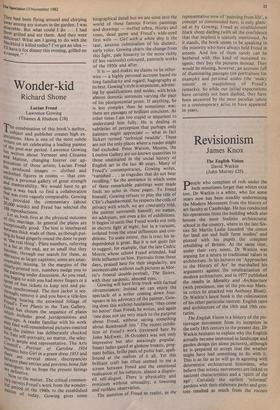Revisionism
James Knox
The English Vision
David Watkin (John Murray £25)
People who complain of reds under the beds sometimes forget that whites exist too. Dr Watkin is a white, who for some years now has been steadily undermining the Modern Movement from the history of art faculty at Cambridge. He has conducted his operations from the building which also houses the most Stalinist architectural school in the country, where in the late Six- ties Sir Martin Leslie founded 'the centre for land use and built form studies' and plotted with his pupils the complete rebuilding of Britain. At the same time, under their very noses, Dr Watkin was arguing for a return to traditional values in architecture. In his lectures on 'Approaches to the History of Art' he marshalled his arguments against the totalitarianism of modern architecture, and in 1977 published the results in Morality and Architecture (with prescience, one of the pre-war Marx- ist critics he attacked was Anthony Blunt). Dr Watkin's latest book is the culmination of his other particular interest: English taste and architecture of the 18th and 19th cen- turies.
The English Vision is a history of the pic- turesque movement from its inception in the early 18th century to the present day. Dr Watkin hesitates to explain why the English actually became interested in landscape and garden design (let alone pictures), although he is prepared to accept that the weather might have had something to do with it. This is as far as he will go in agreeing with determinist architectural historians, who believe that artistic movements are linked to national characteristics and a 'spirit of the age'. Certainly the earliest 'informal' gardens with their elaborate paths and grot- toes resulted as much from the rococo
fashion for chinoiserie as an English love of liberty and fresh air.
The first landscape painters to fire the imagination of the English were Claude and Poussin. Addison writing in The Spectator in 1709 described an ideal landscape that in his words recalled their works; his descrip- tion which included temples of Virtue, Honour and Vanity in turn inspired Lord Cobham, who was obviously an avid reader, to create the Elysian Fields at Stowe. So powerful was this pursuit of Arcady, that it comes as no surprise that one of the few English buildings that can safely be described as a landmark in the history of European architecture, Stuart's temple at Hagley which used the fluted baseless doric order for the first time since the ancient world, should have been an or- nament in a gentleman's park.
Allusion to the classical world did not have a monopoly over English taste; where the situation was appropriate, or as the patron felt inclined, it was acceptable to build in any style. As Christopher Hussey in his pioneering book on the picturesque (acknowledged by Dr Watkin) has pointed out 'it is not except in rare circumstances a style, but a method of using and combining styles.' This freedom meant architects could use different styles to create different moods: from the sublime as at Fonthill and Culzean to the ridiculous as at King Alfred's hall in Cirencester Park, which in a contemporary illustration was described as follows: 'This appears to have been a very antient building and by an inscription thereon is said to have been repaired in the year 1085.' Architects as eminent as Adam and Chambers even illustrated their plans as if they were ruins, achieving the ultimate dethronement of architecture and underlin- ing the historical and literary associations behind picturesque design. Another central tenet was the use of illusion; Edmund Burke, one of the leading theorists of the picturesque, wrote `no work of art can be great, but as it deceives.' Thus distant gothic towers housed game keepers, severe doric temples the gentry and oriental pavilions the heir to the British throne. Only hermits faced up to reality by shelter- ing in the elaborately picturesque cells and caves 'purpose built' for them.
The picturesque brought out the best in architects: a respect for the internal tradi- tions of their art, a sense of humour, a sen- sitivity to their surroundings and a humility which in no way crushed their individuality. Its principles influenced the design of castles, follies, cottages, comfortable suburban houses and even cities throughout the 18th and 19th centuries. Dr Watkin has proved that it was not a passing fad, but a powerful aesthetic force, which in his view constitutes 'the major English contribution to European aesthetics.' But this book is not just architectural history, it is also an elegant mopping up operation, which once and for all answers those modernists who still believe that 'function', 'truth to materials' and a reflection of 'the spirit of the age' are essential to good architecture.















































 Previous page
Previous page